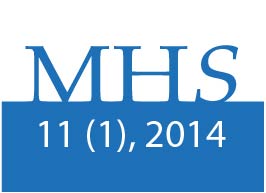Physical Fitness and its Relationship to Depressive Traits in Older Adults Undertaking Physical Activity
DOI:
https://doi.org/10.15359/mhs.11-1.4Keywords:
depression, older adults, aging, physical fitness, physical activity,Abstract
The purpose of this study was to determine the relationship between physical fitness and levels of depression in older persons involved in physical activity programs in San Ramon, Alajuela. A total of 138 older adults aged 60 to 86 years (67.94 ± 5.26) were assessed on the physical fitness using the SFT and levels of depression were measured using the GDS. Results suggest that about 97.8% of persons tested were within normal parameters and excellent on their physical fitness. Additionally, 86.2% of the cohort was found in a normal stage of depression. In addition, geriatric depression was negatively correlated with physical fitness on variables such as lower body muscle strength and endurance, arm muscle strength endurance, physical agility and dynamic balance, and lower body flexibility (p<0.05). It is concluded that higher levels of physical fitness are associated with lower depression status in older adults.
References
Al-Shair, K., Dockry, R., Mallia-Milanes, B., Kolsum, U., Singh, D., & Vestbo, J. (2008). Depression and its relationship with poor exercise capacity, BODE index and muscle wasting in COPD. ELSEVIER. Journal of Respiratory Medicine, 103, 1572-1579. https://doi.org/10.1016/j.rmed.2008.11.021
Cáceres, R. (2004). Estado de salud, físico y mental de los adultos mayores del área rural de Costa Rica, 2000. Revista Electrónica Población y Salud en Mesoamérica, 1(2), 1-28. https://doi.org/10.15517/psm.v1i2.13931
Chaves, J., Lozano, E., Lara, A. y Velázquez, O. (s.f). La actividad física y el deporte en el adulto mayor, bases fisiológicas. México. Recuperado de http://www.salud.gob.mx/unidades/cdi/documentos/DOCSAL7516.pdf
Dunn, A., Trivedi, M., & O’Neal, H. (2001). Physical activity dose-response effects on outcomes of depression and anxiety. Medicine & Science in Sports & Exercise, 33(6), 587–597. https://doi.org/10.1097/00005768-200106001-00027
Hays, J., Krishnan, R., George, L., Pieper, C., Flintfd, E., & Blazera, D. (1997). Psychosocial and physical correlates of chronic depression. Psychiatry Research, 72, 149-159. https://doi.org/10.1016/S0165-1781(97)00105-4
Heun, R., & Hein, S. (2005). Risk factors of major depression in the elderly. European Psychiatry, 20(3), 199–204. https://doi.org/10.1016/j.eurpsy.2004.09.036
Kurlowicz, L. (2007). La escala de depresión geriátrica (GDS, por sus siglas en inglés). The Hartford Institute for Geriatric Nursing, New York University, College of Nursing, 4. Recuperado de http://consultgerirn.org/uploads/File/trythis/try_this_4_span.pdf
Mather, A., Rodriguez, C., Guthrie, M., McHarg, A., Reid, I., & McMurdo, M. (2002). Effects of exercise on depressive symptoms in older adults with poorly responsive depressive disorder Randomized controlled trial. The British Journal of Psychiatry, 180, 411-415. https://doi.org/10.1192/bjp.180.5.411
Menchetti, M., Cevenini, N., De Ronchi, D., Quartesan, R., & Berardi, D. (2006). Depression and frequent attendance in elderly primary care patients. General Hospital Psychiatry, 28(2), 119– 124. https://doi.org/10.1016/j.genhosppsych.2005.10.007
Mura, G., & Carta, M. (2013). Physical activity in depressed elderly. A systematic review. Clinical Practice & Epidemiology in Mental Health, 9, 125-135. https://doi.org/10.2174/1745017901309010125
Orfila, F., Ferrer, M., Lamarca, R., Tebe, C., Domingo-Salvany, A., & Alonso, J. (2006). Gender differences in health-related quality of life among the elderly: The role of objective functional capacity and chronic conditions. Social Science & Medicine, 63, 2367–2380. https://doi.org/10.1016/j.socscimed.2006.06.017
Organización Panamericana de la Salud. (2004). La salud de las personas adultas mayores en Costa Rica / Organización Panamericana de la Salud, Ministerio de Salud, Consejo Nacional del Adulto Mayor. -- San José, C.R.: OPS 56(16) (Serie Análisis de Situación de Salud. 12. Recuperado de http://bvs.sa.cr/php/situacion/adulto.pdf
Rikli, R., & Jones, J. (2001). Senior Fitness Test Manual. USA: Human Kinetics.
Runcan, P., Hategan, M., Carmen Barbat, C., & Alexiu, M. (2010). The emergence of depression in the elderly. Procedia Social and Behavioral Sciences, 2(2), 4966–4971.
https://doi.org/10.1016/j.sbspro.2010.03.804
Saks, K., Tiit, E., Kaarik, E., & Jaanson, K. (2002). Depressive symptoms in older Estonians: prevalence and models. Journal of the American Geriatrics Society, 50(6), 1164–1165. https://doi.org/10.1046/j.1532-5415.2002.50280.x
Strawbridge, W., Deleger, S., Roberts, R., & Kaplan, G. (2002). Physical activity reduces the risk of subsequent depression for older adults. American Journal of Epidemiology, 156(4), 328-334. https://doi.org/10.1093/aje/kwf047
Torre, F., Martín-Corral J., Callejo A., Gómez-Vega C., La Torre S., Esteban, I., Vallejo R. M. y Arizaga, A. (2008). Calidad de vida relacionada con la salud y estrategias de afrontamiento ante el dolor en pacientes atendidos por una unidad de tratamiento del dolor. Revista Sociedad Española del Dolor, 15(2), 83-93. Recuperado de http://scielo.isciii.es/pdf/dolor/v15n2/original3.pdf
Unsar, S., & Sut, N. (2010), Depression and health status in elderly hospitalized patients with chronic illness. Archives of Gerontology and Geriatrics, 50(1), 6–10.
https://doi.org/10.1016/j.archger.2008.12.011
Wada, T., Ishine, M., Sakagami, T., Kita, T., Okumiya, K., Mizuno, K., Rambo, T.A., & Matsubayashi, K. (2005). Depression, activities of daily living, and quality of life of community-dwelling elderly in three Asian countries: Indonesia, Vietnam, and Japan. Archives of Gerontology and Geriatrics, 41(3). 271–280. https://doi.org/10.1016/j.archger.2005.03.003
Wada, T., Ishine, M., Sakagami T., Okumiya, K., Fujisawa, M., Murakami, S., Otsuka, K., Yano, S., Kita, T., & Matsubayashi K. (2004). Depression in Japanese community-dwelling elderly—prevalence and association with ADL and QOL. Archives of Gerontology and Geriatrics, 39, 15-23. https://doi.org/10.1016/j.archger.2003.12.003
Whooley, M. A., Stone, B., & Soghikian, K. (2000). Randomized trial of case-finding for depression in elderly primary care patients. Journal General Internal Medicine, 15(5), 293–300. https://doi.org/10.1046/j.1525-1497.2000.04319.x
Downloads
Published
How to Cite
Issue
Section
License
General conditions
MHSalud: Journal in Human Movement Sciences and Health by the Universidad Nacional is cover under a Creative Commons Atribución-NoComercial-SinDerivadas 3.0 Costa Rica license.
The journal is hosted in open access repositories such as the Institutional Repository of the Universidad Nacional, the Kimuk Repository of Costa Rica and La Referencia.
The editorial source of the journal must be recognized. Use the doi identifier for this purpose.
Self-archiving policy: The journal allows the self-archiving of the articles in their peer-reviewed version, edited and approved by the Editorial Board of the Journal to be available in Open Access through the Internet. More information in the following link: https://v2.sherpa.ac.uk/id/publication/25815



















